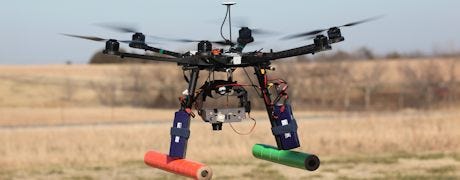
The biggest thing on the horizon in precision agriculture is Unmanned Aerial Vehicle flights, according to a new report from the Association for Unmanned Vehicle Systems International.
Kansas, already a leader in research on the vehicles that are expected to see explosive growth when integration into national airspace begins in 2015, ranks No. 7 among states likely to see economic benefits the report says, with the state expected to see a $2.9 billion impact and 3,700 new jobs between 2015 and 2025.

Aerial sensing with the hexacopter, can provide mapping of an entire section of land at 1-inch resolution in about 18 minutes – a task that would take hours if not days on a tractor.
The greatest area of growth indicated by the report will be in precision agriculture, which is slated to grow 10 times that of the public safety market for UAS. Precision agriculture use of UAS refers to two segments of the farm market: remote sensing used to scan plants for health problems, growth rates and hydration; and precision application of needed pesticides or nutrients in order to save money and reduce environmental impact.
Members of the Kansas Ag Research and Technology Association got an upclose look at the work that is being done at Kansas State University by agronomy professor Kevin Price, who is working closely with Deon van der Merwe, head of the toxicology section at the K-State Veterinary Diagnostic Laboratory.
UAVs can help monitor crop conditions
Van der Merwe is a remote-controlled aircraft enthusiast who is excited about the prospect of using UAVs, commonly referred to as drones, to detect blue-green algae blooms in bodies of water.
Price brought two aircraft to the KARTA conference, a flying wing by RiteWingRC called the Zephyr II and a DJI S800 Spreading Wings hexacopter.
Price said the promise of using the aircraft to do remote sensing to monitor crop condition, detect diseases and map fields for variable rate application of nutrients or pinpoint areas for fungicide or pesticide application, is huge.
Aerial sensing with the hexacopter, for example, can provide mapping of an entire section of land at 1-inch resolution in about 18 minutes – a task that would take hours if not days on a tractor.
You can read more about the K-State Unmanned Aerial Vehicle program in the March, 2013 Kansas Farmer magazine. Find it online at the Farm Progress website. Click on Magazine Online and go to Page 21.
The entire AUVSI report on the economic prospects of unmanned vehicles can be found here.
About the Author(s)
You May Also Like




